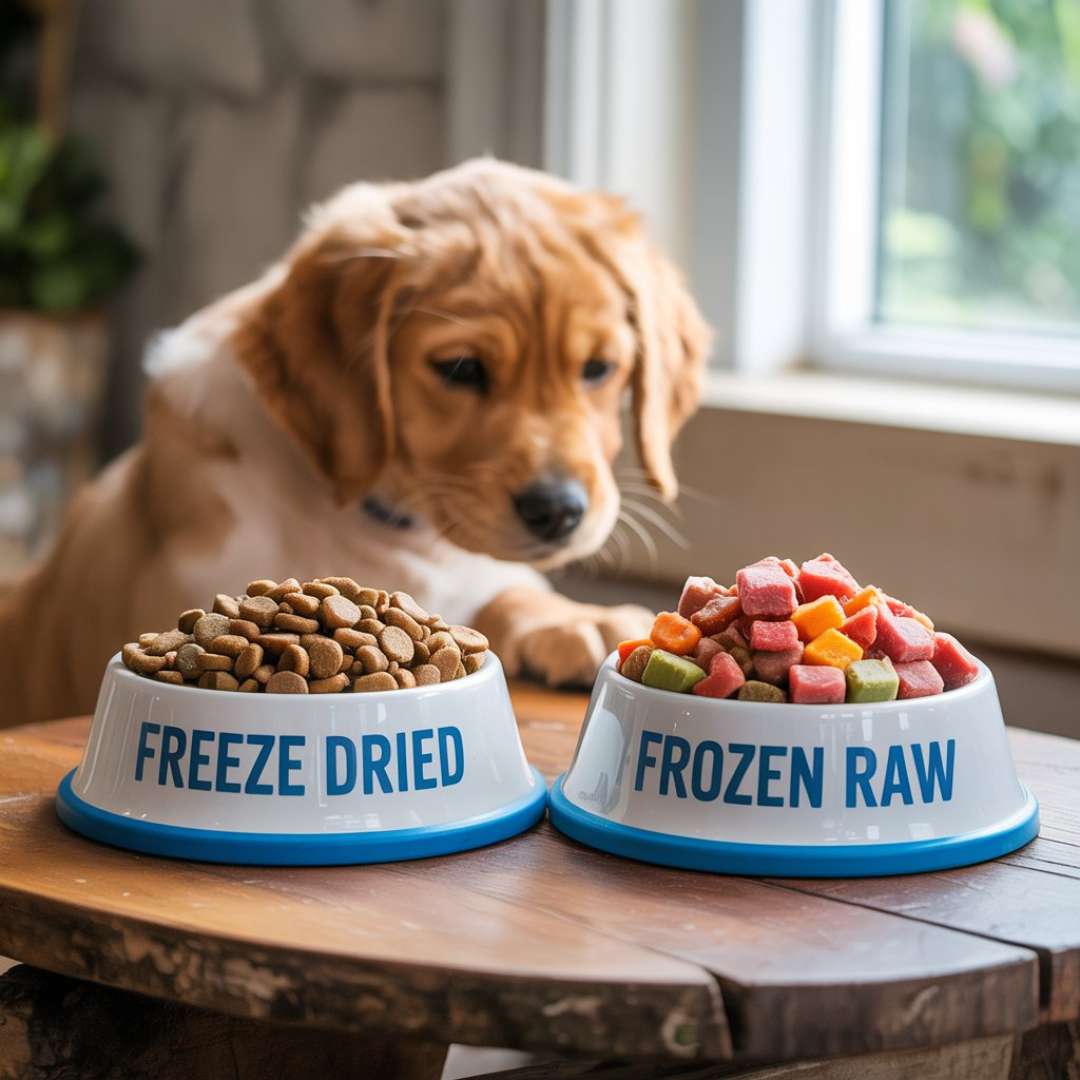You’re trying to feed your dog better—but the raw food aisle is confusing.
You’ve probably heard that raw feeding can mean fewer vet visits, shinier coats, and even a longer life for your pup. But then reality hits: freezer space is tight, your dog’s picky, you travel often, and raw feeding isn’t cheap.
So how do you decide between freeze dried vs frozen raw dog food?
Both offer the benefits of raw, minimally processed meals. But how they’re made, how they store, how they taste—and how much they cost—can make a big difference.
Let’s break it all down.
What is Freeze-Dried Dog Food?
Freeze-dried dog food is raw food that’s had its moisture removed using cold vacuum technology.
This process—called sublimation—removes moisture without heat. That means the food stays raw, but shelf-stable.
The Freeze-Drying Process (Made Simple)
First, the food is frozen, and then it is placed in a vacuum chamber. Ice inside the food turns into vapor and evaporates, leaving behind a dry, nutrient-dense piece of food.
No cooking. Just preservation.
What’s In It?
Freeze-dried raw dog food usually includes:
- Muscle meat (beef, chicken, turkey, etc.)
- Organ meats (like liver or heart)
- Ground bone (for calcium)
- Optional: fruits, vegetables, omega-3 oils, and probiotics
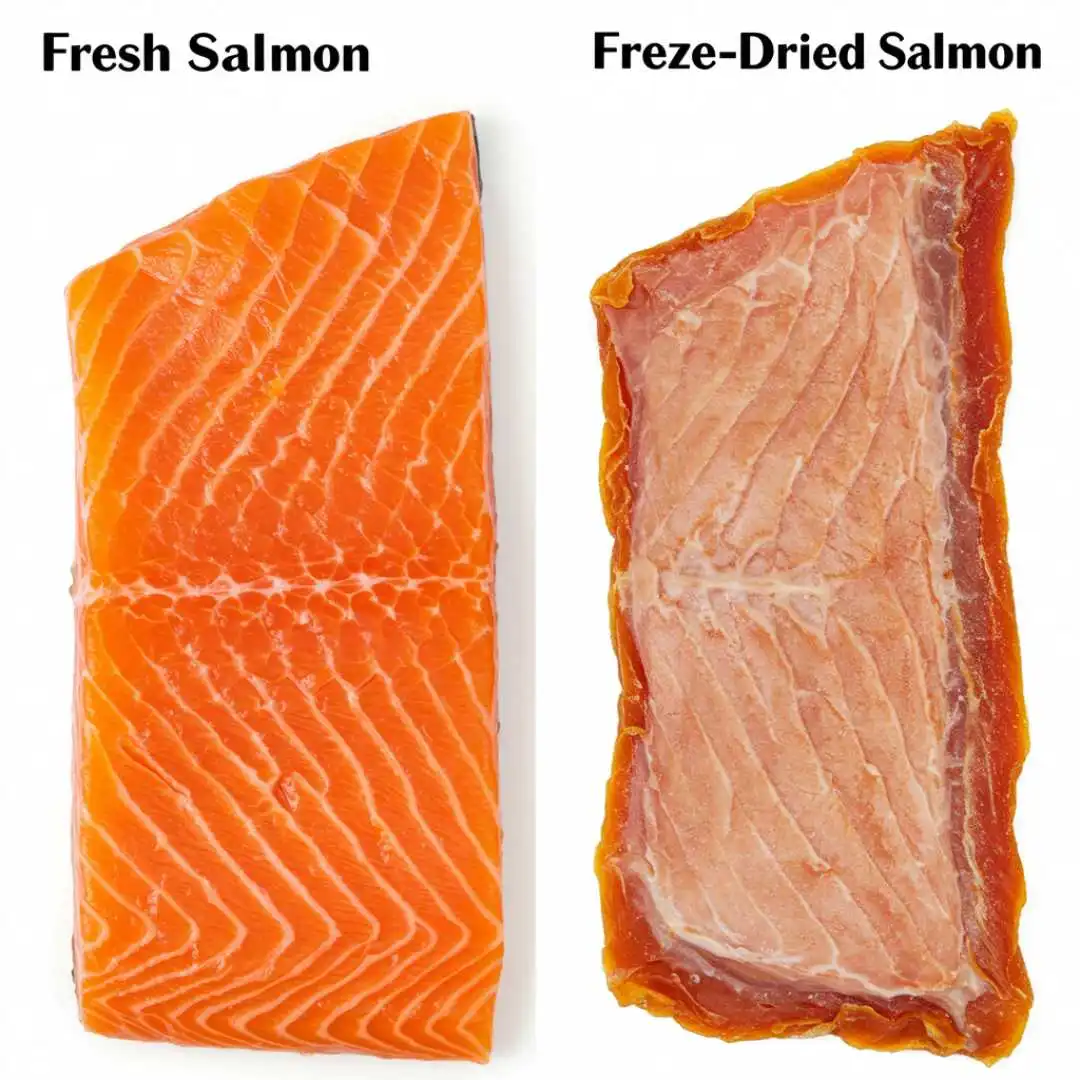
What is Frozen Raw Dog Food?
Frozen raw dog food is raw meat and other ingredients stored in the freezer to keep it fresh.
This format is the closest to feeding your dog a real, uncooked meal.
How It’s Made
Ingredients are chopped or ground, portioned, and flash-frozen. That’s it. No heat. No drying. Just raw nutrition, frozen solid.
What’s Inside?
- Muscle meat
- Organ meats
- Raw bone
- Sometimes fruits, veggies, or supplements
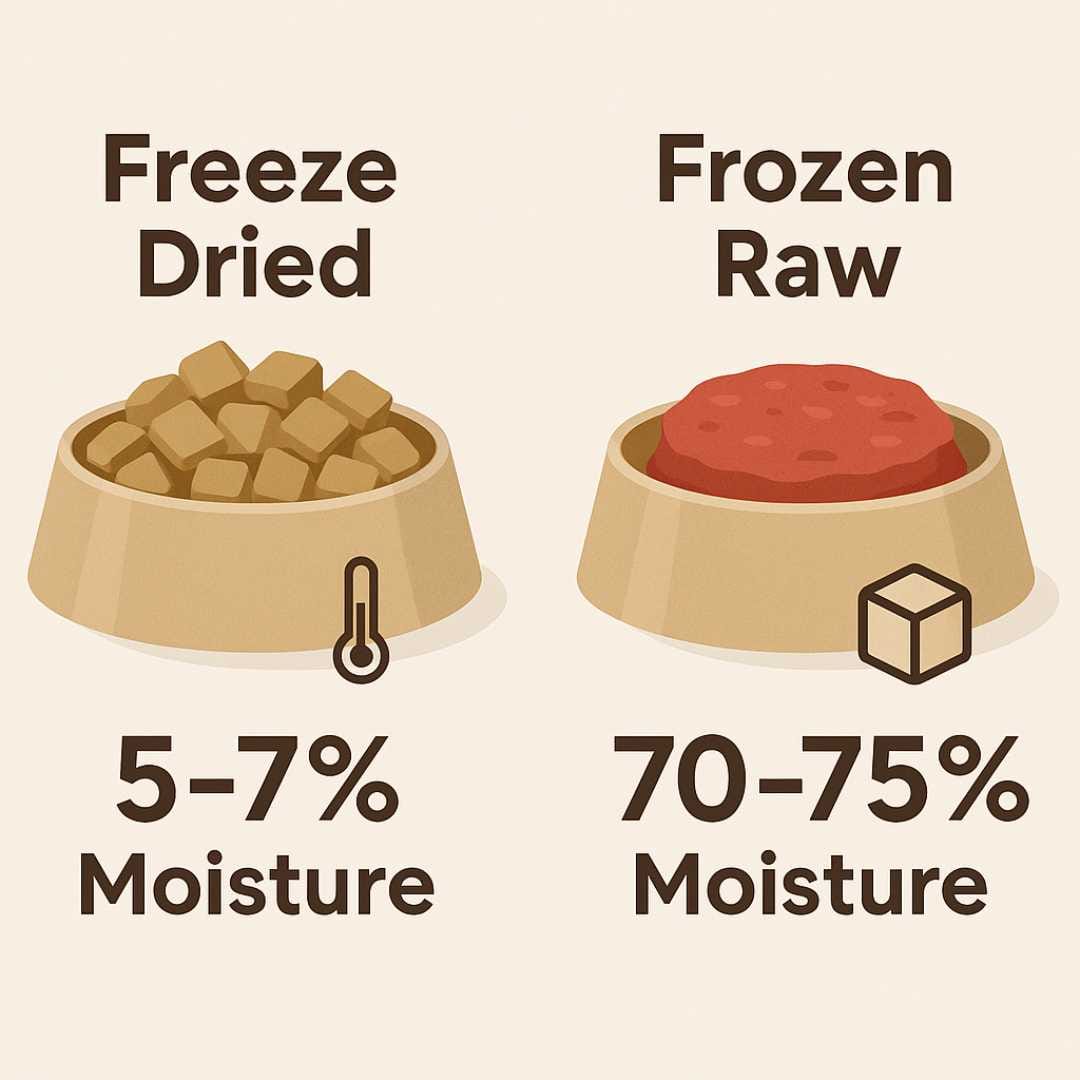
Freeze Dried vs Frozen Raw: A Quick Snapshot
| Feature | Freeze Dried | Frozen Raw |
|---|---|---|
| Storage | Pantry or cupboard | Requires freezer |
| Shelf Life | 1–5 years sealed | 6–12 months frozen |
| Cost | $$$ (higher) | $$ (more affordable) |
| Texture | Dry or crumbly | Moist, natural |
| Protein Variety | Usually 2–3 options | Often 5–6+ options |
| Best For… | Travel, busy owners | At-home feeders, big dogs |
“Freeze-Dried vs Frozen Raw Dog Food – Quick Comparison”
| Feature | Freeze-Dried | Frozen Raw |
|---|---|---|
| Storage | Pantry (Shelf-Stable) | Freezer Required |
| Shelf Life | 1–5 Years | 6–12 Months |
| Cost | Higher | Lower |
| Texture | Dry Nuggets | Juicy Meat |
| Protein Variety | Limited | Wide Range |
| Travel Friendly | Yes | No |
| Moisture | Low (5–7%) | High (70%+) |
| Prep Time | Minimal | Thaw Required |
Nutritional Comparison
Both freeze-dried and frozen raw retain most nutrients, but frozen raw keeps more moisture and natural enzymes intact.
Frozen raw more closely mimics a wild canine diet, thanks to moisture and active enzymes. Freeze-dried still preserves nutrients, but may need supplements added back in.
Synthetic vitamins are more common in freeze-dried foods. Look out for long chemical names on the ingredient list.
Pro Tip: Want to avoid synthetic additives? Look for real organ meats and bone in the ingredients, not “vitamin packs.”
Convenience, Storage, and Travel
Freeze-dried is lightweight, compact, and ready to serve. Travel with this bag on the road, fly, or keep it in the pantry.
Frozen raw? You’ll need freezer space, time to thaw, and a plan to clean raw meat messes.
Anecdote: Take your dog on a vacation in the summer. Freeze-dried fits in your glove box. Frozen raw? You’re hauling a cooler.
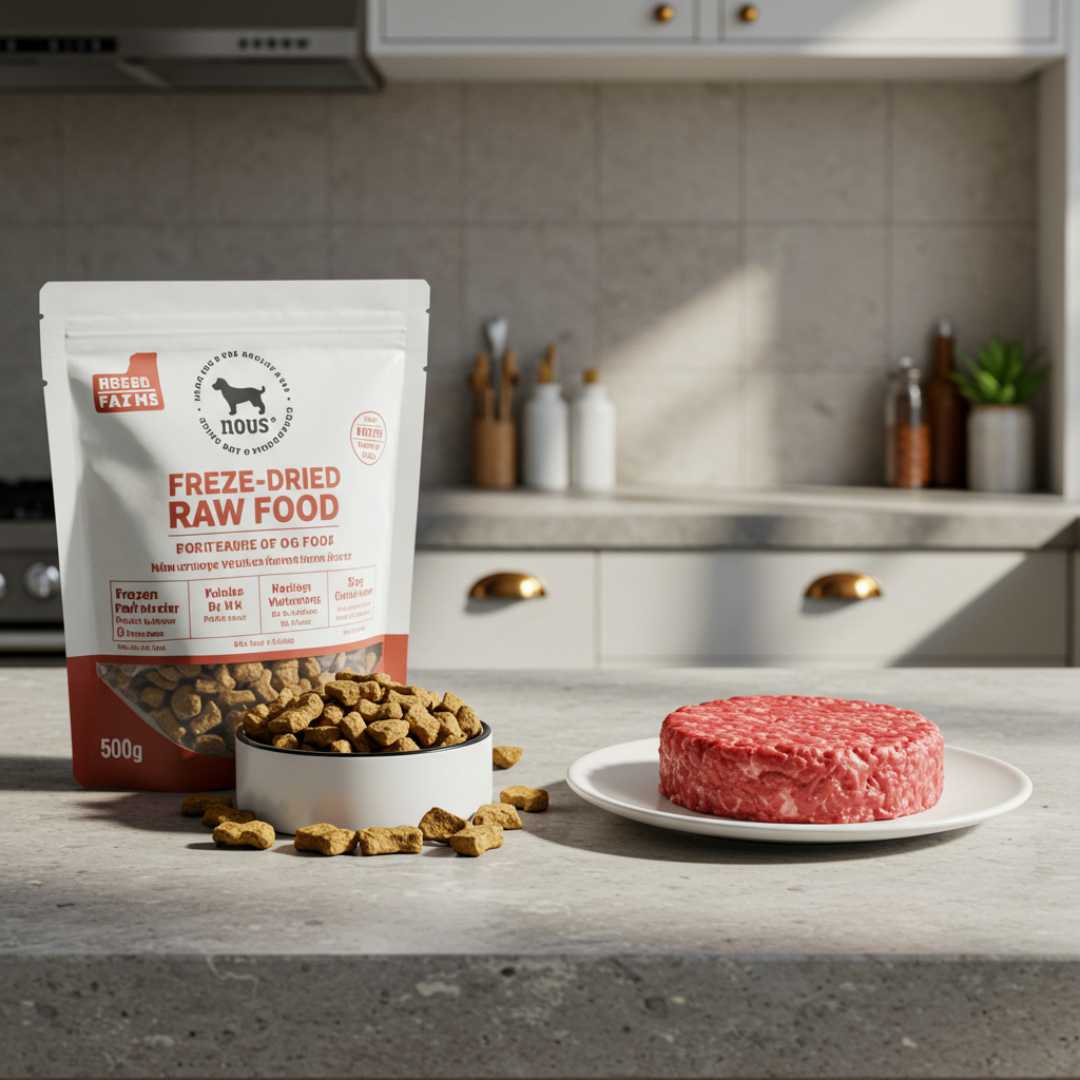
Palatability & Dog Preferences
Dogs often prefer frozen raw for its natural smell and moisture, but some enjoy the crunch of freeze-dried.
If your dog turns up their nose at dry food, try frozen raw. However, freeze-dried foods can be a great treat or transition food.
Tip for picky eaters: Rehydrate freeze-dried with warm bone broth.
Cost Breakdown
Freeze-dried is pricier per pound, especially once rehydrated. But it offers zero waste, no spoilage, and travel-friendly perks.
Frozen raw costs less upfront and often comes in bulk, saving money over time.
Cost Comparison Table (Per 1 lb when rehydrated):
| Format | Estimated Cost | Notes |
|---|---|---|
| Freeze Dried | $15 – $25 | Higher price for convenience, shelf life, and portability |
| Frozen Raw | $4 – $7 | More affordable, especially when bought in bulk |
Callout: Is freeze-dried really worth it? Yes—if you prioritize convenience, travel, and mess-free feeding.
Feeding and Portioning
Freeze-dried is easy to scoop and portion. Just follow the feeding guidelines by weight.
Many brands sell patties, nuggets, or pellets that double as treats.
Frozen raw comes in patties or chubs. You’ll need to thaw, weigh, and prep.
Pro Tip: Rehydrate freeze-dried with bone broth for extra hydration and nutrients.
Food Safety & Hygiene
Both are raw. That means basic precautions matter.
Freeze-dried: Less risk of bacterial contamination. Still handle with care. Frozen raw: Must be thawed safely and served immediately.
HPP (High Pressure Pasteurization): A method used by some brands to kill pathogens without heat.
Safety Tip Box: Always wash hands, clean bowls, and refrigerate leftovers. Don’t feed spoiled, thawed food.
Protein Options & Dietary Flexibility
Frozen raw often comes in more protein types: beef, chicken, turkey, lamb, duck, and venison.
Freeze-dried may be limited to 2–3 varieties per brand.
If your dog has food sensitivities, frozen raw gives more room to rotate proteins.
Freeze Dried for Beginners or Travel
Just getting started with raw feeding? Freeze-dried makes a great stepping stone.
It’s also ideal for:
- Vacations and weekend trips
- Camping
- Small apartments or dorms
- Pet sitters
Backup Plan: Always keep one bag of freeze-dried in the pantry.
Which Dogs Are Best Suited for Each Format?
| Dog Type | Best Format |
| Puppies or seniors | Frozen Raw |
| Allergic or sensitive dogs | Frozen Raw |
| Busy owners/travelers | Freeze Dried |
| Apartment dwellers | Freeze Dried |
| Dogs need extra hydration | Frozen Raw |
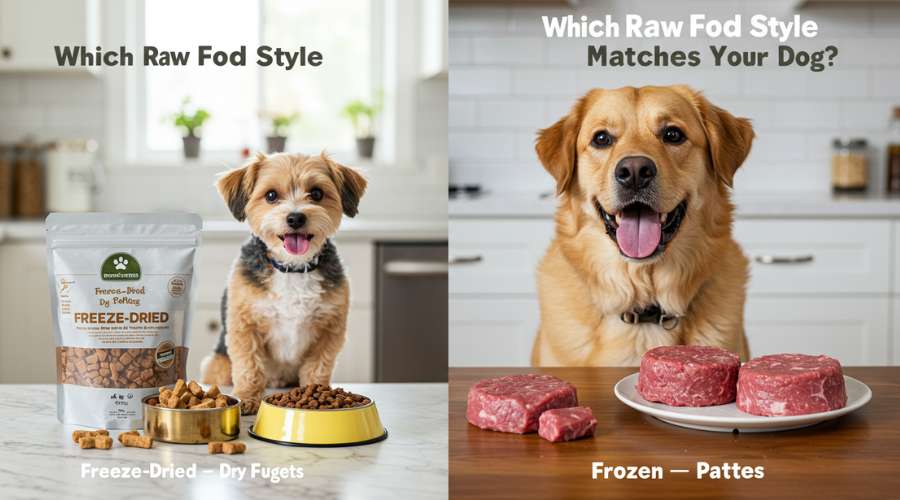
Combining Both Options
You don’t have to choose one over the other.
Many pet parents feed:
- Freeze-dried on weekdays for speed
- Frozen raw on weekends for freshness
Callout: Flexibility, variety, and better nutrition are all benefits of smart feeding.
Pros & Cons List: Freeze Dried vs Frozen Raw
| Feature | Freeze Dried | Frozen Raw |
| Shelf Life | Yes | No |
| Prep Time | Yes | No |
| Natural Moisture | No | Yes |
| Cost | No | Yes |
| Texture | Crunchy | Meaty |
| Travel-Friendly | Yes | No |
| Protein Options | NO | Yes |
Final Thoughts: Choose What Works for You
Whether it’s freeze-dried, frozen raw, or both, either is better than kibble.
You’ll see improvements in digestion, coat shine, energy, and fewer vet visits.
No wrong answer. Just the one that fits your life and your pup’s needs.
Bonus Section: How to Transition Your Dog to Raw
- Start with freeze-dried in small portions.
- Gradually mix in frozen raw.
- Rehydrate with broth or warm water.
- Watch for changes in stool, energy, and appetite.
- Adjust portions based on body weight.
📥 Download Raw_Feeding_Transition_Guide
FAQs of Freeze-Dried vs Frozen Raw Dog Food?
Q1.Is freeze-dried dog food still raw?
Ans. Yes. It’s raw food that’s had the moisture removed through freezing—not cooking.
Q2.Can I mix freeze-dried and frozen raw?
Ans. Absolutely. Many pet parents do this for flexibility, cost savings, or during travel.
Q3.Is frozen raw safer than homemade raw?
Ans. Often, yes—because it’s formulated and tested. Homemade raw requires careful balance.
Q4.How do I store freeze-dried food?
Ans. Keep it in a cool, dry place. Once opened, use within 30 days or refrigerate.
Q5.Can I feed freeze-dried without water?
Ans. Yes, but rehydrating helps prevent dehydration and may be easier to digest.

